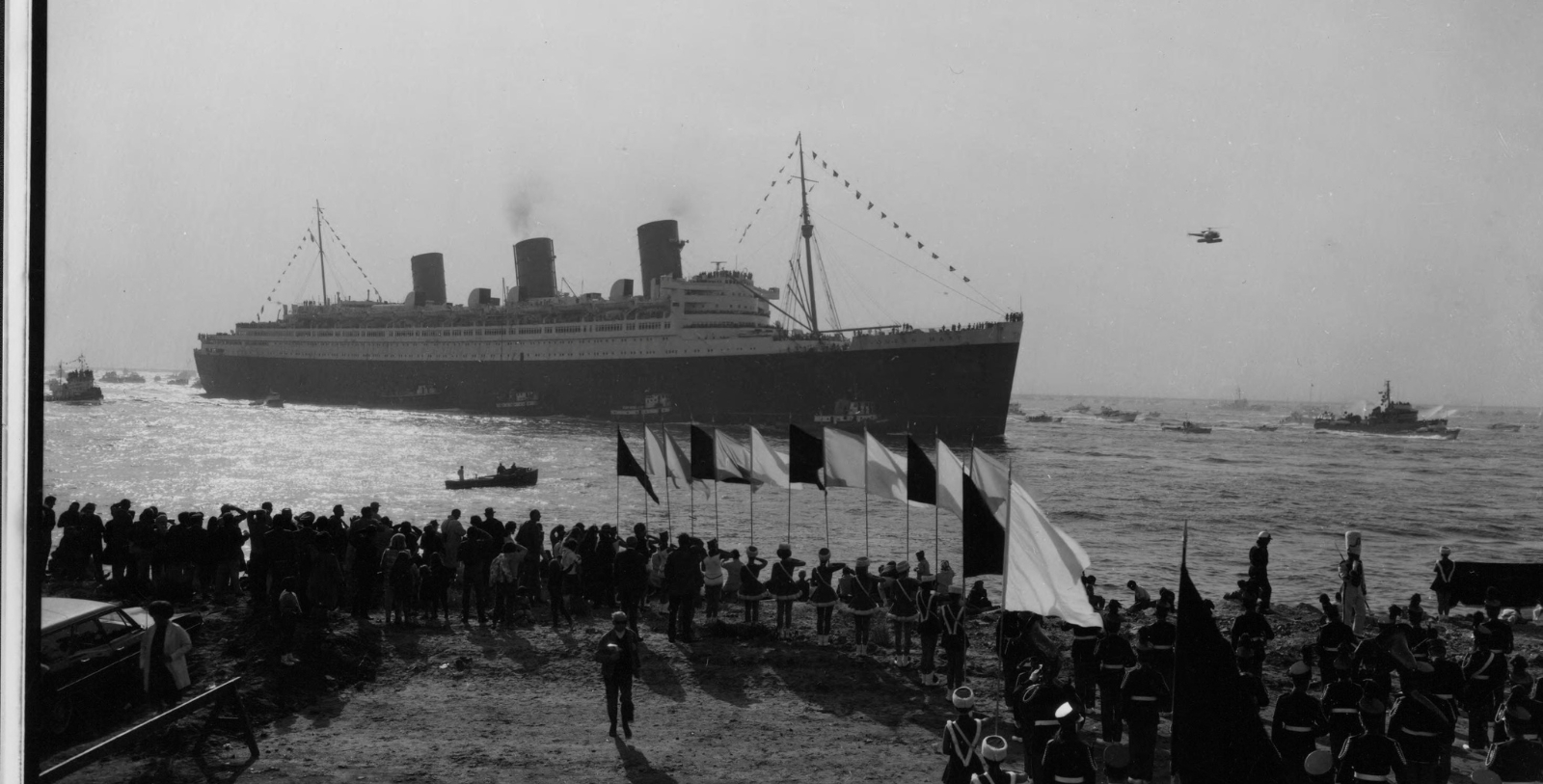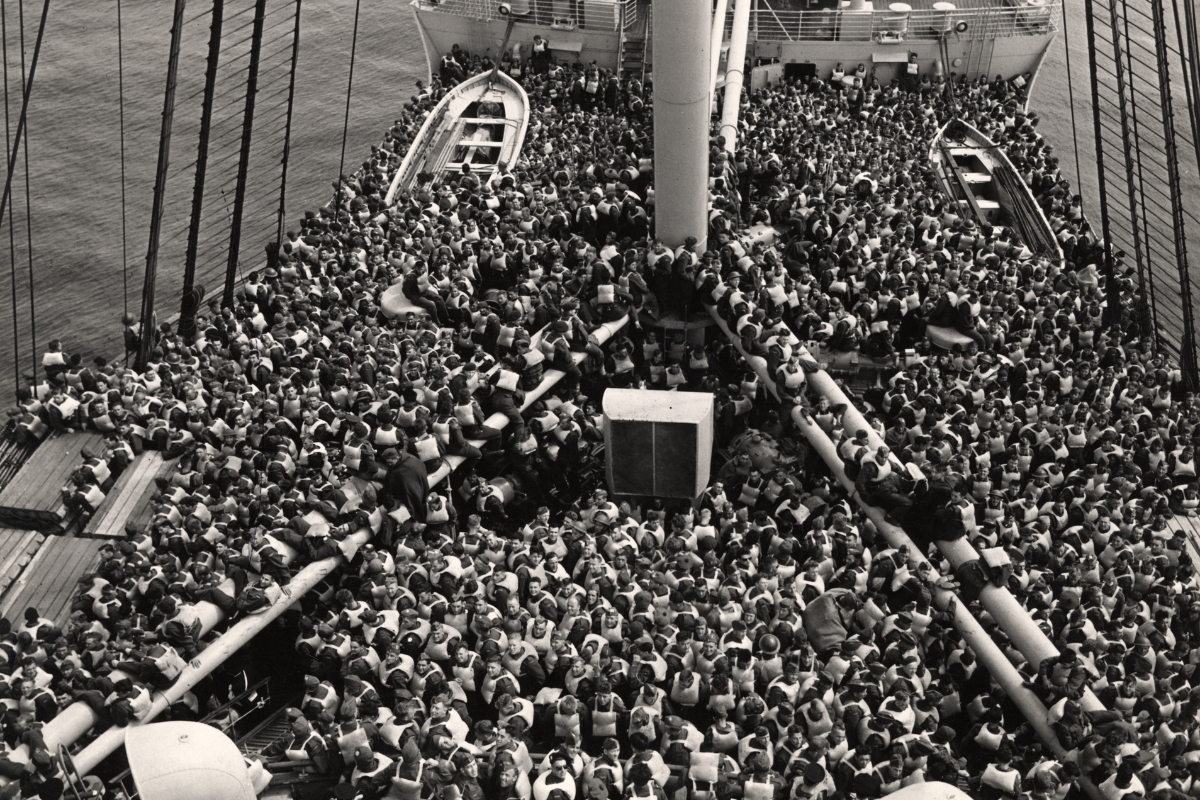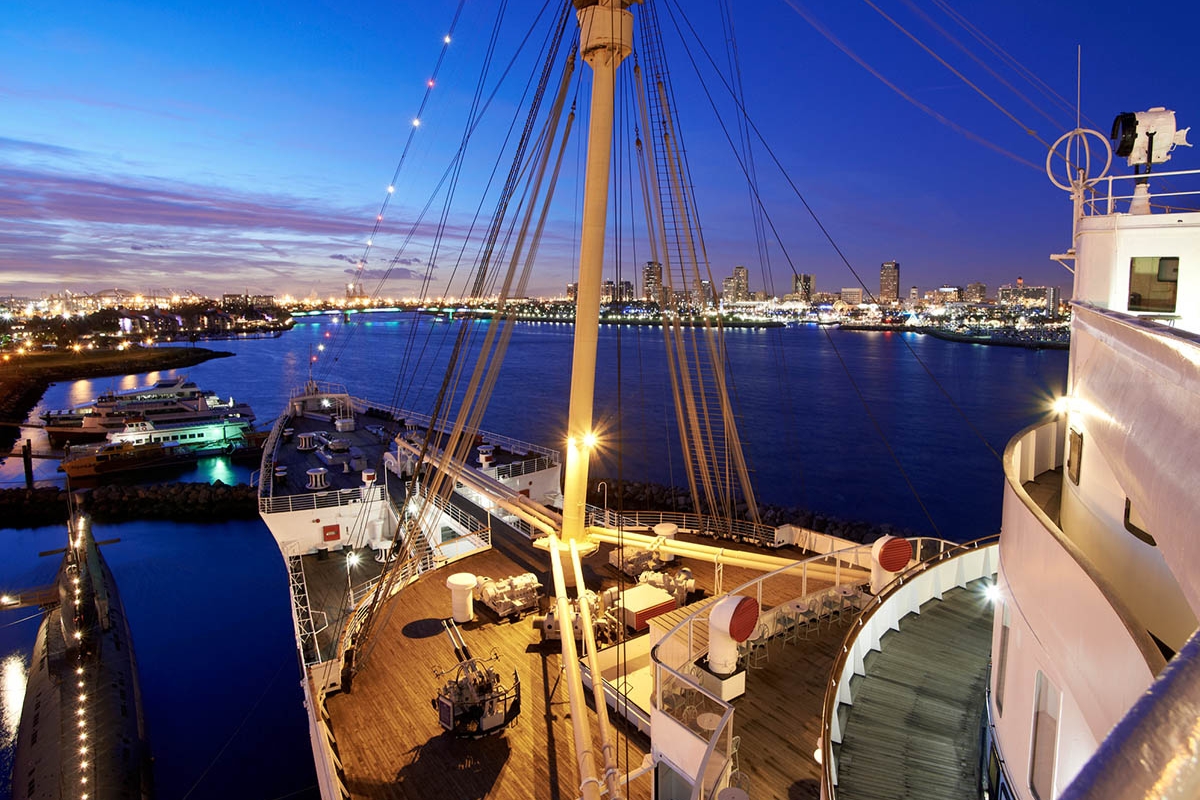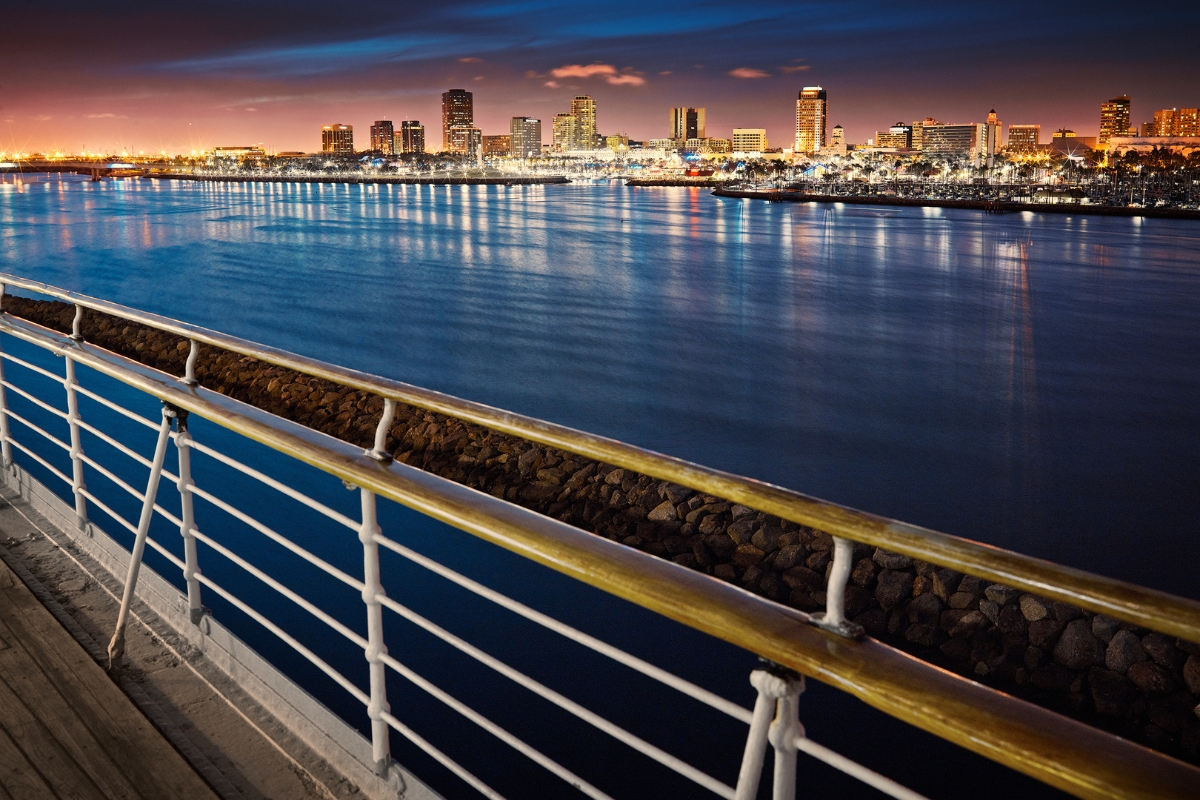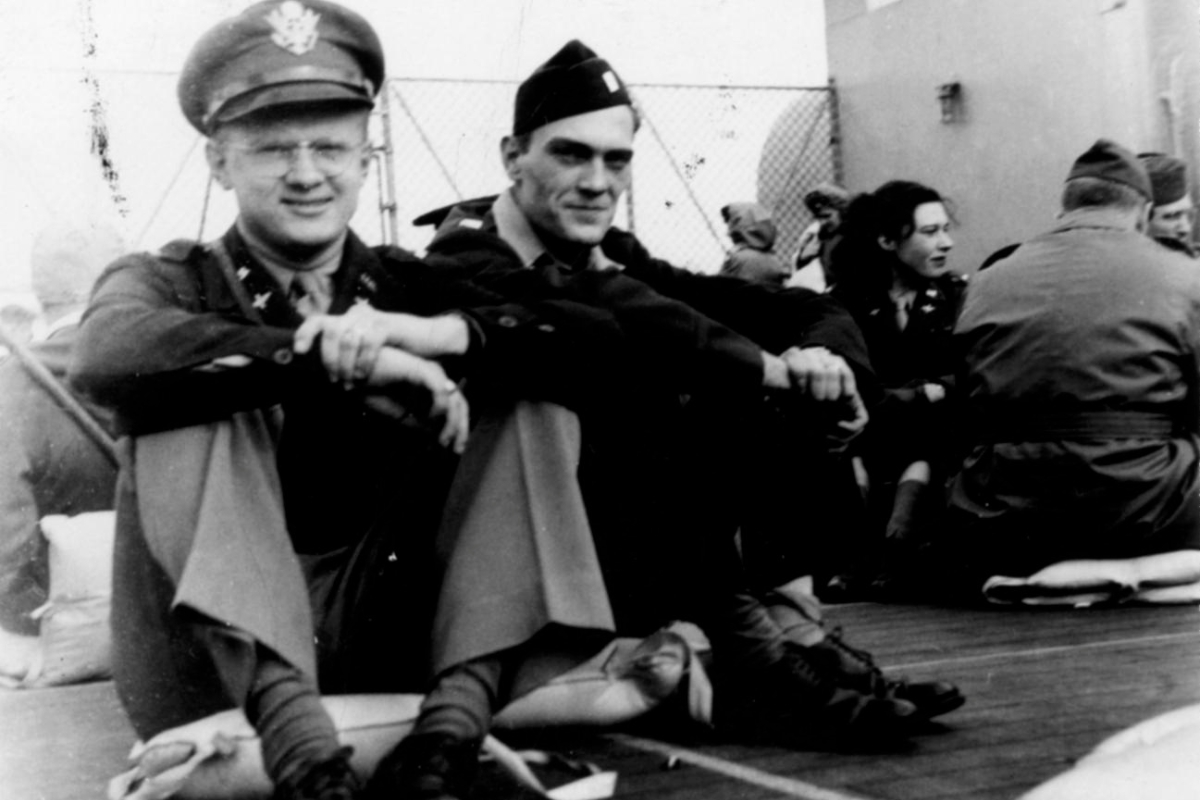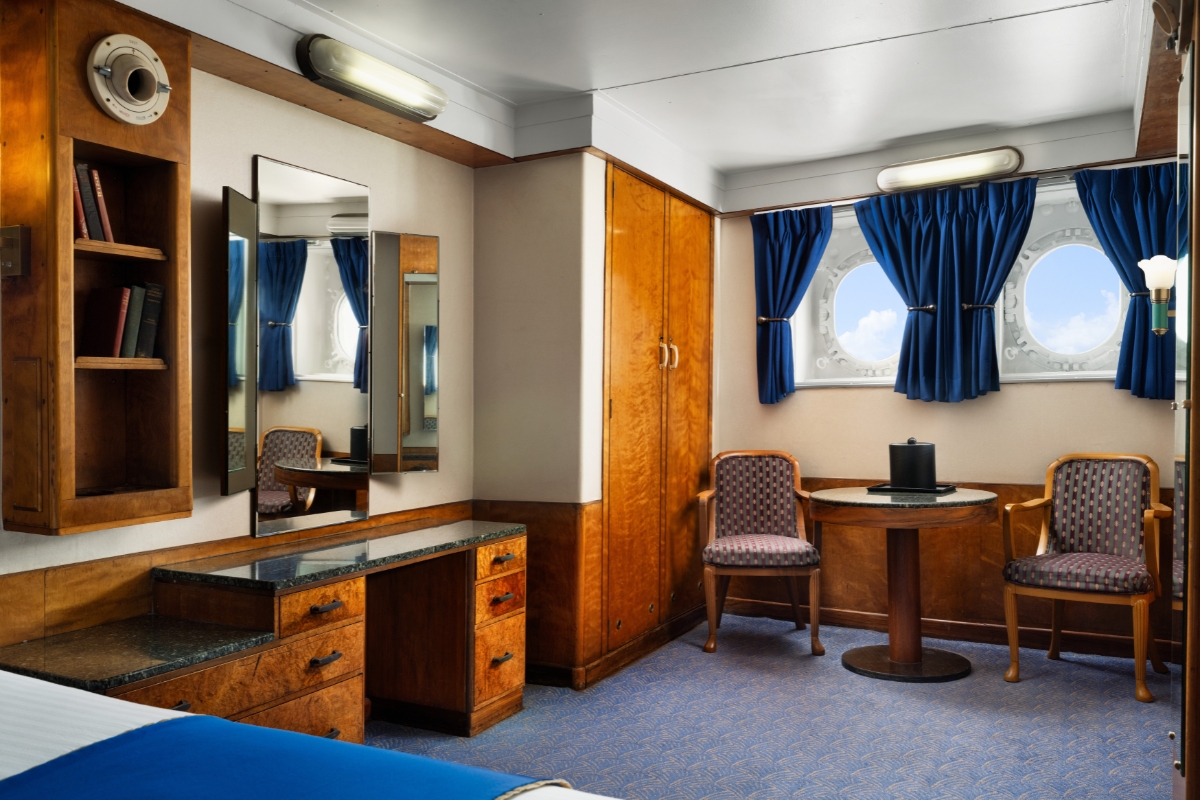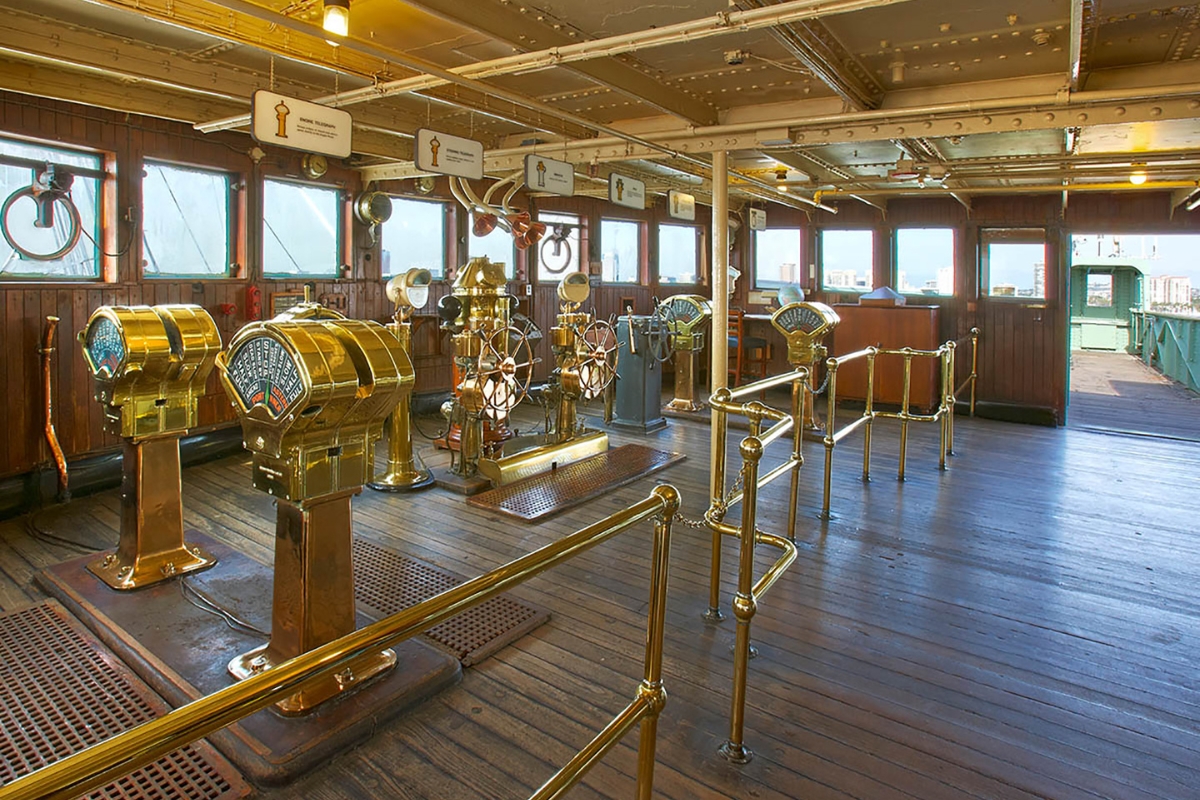Receive for Free - Discover & Explore eNewsletter monthly with advance notice of special offers, packages, and insider savings from 10% - 30% off Best Available Rates at selected hotels.
history
The Queen Mary, a member of Historic Hotels of America since 2024, dates back to 1936.
Discover The Queen Mary, which was once the most elite ocean liner to ever set sail for the historic Cunard Line.
VIEW TIMELINEListed in the U.S. National Register of Historic Places—and designated as a California Historical Landmark—The Queen Mary is one of the most distinctive destinations throughout the entire country. From the 1930s to the 1960s, this majestic ocean liner famously entertained thousands of visitors annually, granting them access to 347 upscale staterooms and a wealth of exhilarating tours, exhibits, and experiences to discover. But while this esteemed historic landmark functions as both a luxury hotel and nautical museum today, The Queen Mary was once a legendary British ocean liner operated by the equally historic Cunard Line. More specifically, the origins of the vessel harken back to the early 20th century when the international cruise line industry was at the height of its prosperity. Companies located in North America and Europe introduced glamorous passenger ships that provided only the best in luxury comfort. Foremost among those businesses was the British-based Cunard Line, which had been conducting successful transatlantic voyages since the 1830s. Despite its prestige, increased competition from more modern French and German ocean liners began to pose a risk to the Cunard Line’s profitability. To remedy the situation, the corporation decided to develop two state-of-the-art ships capable of surpassing their rivals in both elegance and efficiency. Cunard Line’s chief naval architect, George Mcleod Paterson, started to draft blueprints for the project during the mid-1920s, taking great pains to ensure that each ship surpassed all expectations.
Paterson intricately designed an ingenious prototype that totaled an astonishing length of 1,019 feet, as well as 80,000 cubic feet in gross register tonnage. The ship’s size did not affect its speed, as it could achieve a maximum setting of around 30 knots. Internally, Paterson divided the model into a dozen decks capable of hosting around 2,000 passengers one way. The levels contained many resplendent guest cabins, which were further arranged by three different class types. Paterson had also set aside more space for a stunning array of terrific public facilities that included four specialty restaurants, two libraries, a full-service spa, and a massive gymnasium. Amazingly, the ship could even maintain a functional hospital, as well as an expansive shopping mall! Impressed by Paterson’s designs, the Cunard Line went about manufacturing the first ocean liner of the serial in 1930. Work commenced at the celebrated John Brown & Company shipyard in Scotland’s Clydebank harbor, with the initial keel plates bolted together in the neighboring River Clyde that December. Referred to only as “Job #534,” the ship underwent constant construction for several months. Soon enough, the huge ocean liner began to take shape as its towering steel frame gradually came to dominate the local skyline. However, the worsening economic climate of the Great Depression made continuing the endeavor increasingly difficult and forced the Cunard Line to halt production.
Desperate for a solution, the Cunard Line looked to the British government for assistance in the form of a public loan. The two sides managed to strike a deal with the company agreeing to absorb another struggling British ocean liner, the White Star Line, as part of the terms. Its finances now secure, the Cunard Line quickly resumed building the nascent ship in 1934. Hundreds of workers were once again scurrying across the Clydebank docks, busily outfitting the Cunard Line’s gorgeous vessel with lavish Art Deco architectural details. The most striking features installed were a diverse assortment of wood-paneling, which had been carved from over 50 distinct species of tree found throughout the British Empire. When construction on the ship concluded, it truly stood as one of the finest ocean liners on the planet. Christened the “RMS Queen Mary” in honor of King George V’s wife, Mary of Teck, the new ship made its maiden voyage on May 27, 1936. Along with its sibling, the RMS Queen Elizabeth, the RMS Queen Mary went on to run weekly express trips between England and the United States for over the next 30 years. Thanks to Paterson’s imaginative designs, the ship had no trouble outpacing similar vessels navigating the Atlantic at the time. In fact, the RMS Queen Mary managed to win the prestigious Blue Riband accolade for best maritime speed not long after its debut, signifying its status as the fastest ocean liner then in active service! (Remarkably, the RMS Queen Mary would win the award regularly until the early 1950s).
The awe-inspiring size, speed, and strength of the RMS Queen Mary were prime reasons why it became a troopship at the start of World War II. Undergoing a thorough conversion safely in America, the ocean liner received a monochromatic color scheme that earned it the new nickname of the “Grey Ghost.” Leather soon covered the rich timber panels, while triple-tiered bunks temporarily replaced the plush guestroom beds. Novel military inventions were affixed to its hull, including a degaussing coil that protected against magnetic mines. Those changes helped make RMS Queen Mary an extremely effective transport during the conflict, often ferrying up to 15,000 Allied military personnel on a single journey. After finishing its tour of duty, the RMS Queen Mary returned to being one of the world’s finest ocean liners. The ships would entertain countless celebrities of significant renown, including Audrey Hepburn, Clark Gable, Elizabeth Taylor, Spencer Tracy, Gary Cooper, Judy Garland, Errol Flynn, Loretta Young, and Fred Astaire. British Prime Minister Winston Churchill sailed as a passenger on three separate occasions, with his last voyage transpiring alongside his political successor, Anthony Eden. Two U.S. Presidents, Dwight D. Eisenhower and John F. Kennedy, were guests aboard the RMS Queen Mary, as was Great Britain’s longest reigning monarch, Queen Elizabeth II!
Nevertheless, the advent of affordable air travel increasingly eroded the ship's popularity, causing the Cunard Line to eventually retire it in 1967. The historic vessel partook on its final expedition later that year, leaving the misty shores of her English home in Southampton to reach the sunny port of Long Beach, California. Upon arrival, the City of Long Beach officially took over the stewardship of the RMS Queen Mary, which readapted it for use as a stationary hotel and entertainment venue called “The Queen Mary.” The smaller first-class public rooms, such as the drawing room, lecture room, and libraries, were altered to house boutique storefronts and extravagant meeting halls. Meanwhile, the ship’s gorgeous staterooms underwent a modernization that made them meet the expectations of the contemporary travelers. Deck by deck and stateroom by stateroom, this legendary ocean liner steadily emerged as the luxurious hotel and event center that the City of Long Beach had intended. Following years of thorough renovations, The Queen Mary finally opened before thunderous applause during the early 1970s. Unfortunately, the operator of The Queen Mary could not maintain the ship. Former Mayor Robert Garcia and supporters from across the country rallied to support the preservation of the ocean liner, instituting their own comprehensive, $43 million renovation. Reopening in 2023, The Queen Mary returned to being one of the most prominent cultural attractions in the western United States. This fantastic historic site has gone on to host over 118,000 guests, all of whom have thoroughly enjoyed learning about its impressive heritage and timeless grandeur.
-
About the Location +
Located approximately an hour south of downtown Los Angeles, the City of Long Beach has been consistently considered to be among the most prominent cities in Southern California. Its history is quite extensive, harkening back centuries. Although the indigenous Tongva people once inhabited the land generations ago, Long Beach’s direct origins relate to a historic land grant known as the “Rancho Los Nietos.” Measuring 167,000 acres in total size, King Carlos III of Spain had specifically given the concession to colonial soldier Manuel Nieto during the mid-1780s. Nieto subsequently governed over the expanse of land for many years with his descendants inheriting the area upon his death in 1804. But the Nieto family would encounter trouble maintaining the territory throughout the early 19th century, prompting them to find ways to reduce their liability. In the 1830s, the Nietos convinced California’s then-Mexican governor José Figueroa to subdivide it into five smaller estates. Figueroa in turn had centered the boundaries for two of those newly created land grants, Rancho Los Cerritos, and Rancho Los Alamitos, along the central axis of Signal Hill in present-day Long Beach.
While Rancho Los Alamitos was slightly larger, it was Rancho Los Cerritos that would come to constitute most of Long Beach’s current borders. Rancho Los Cerritos had been given to administrator Guillermo Cota and his family by José Figueroa in 1834. The estate remained under the control of the Cota family for the next ten years until Cota’s daughter Rafaela married an American-born rancher named Juan Temple. (Temple was actually born “Jonathan,” but changed his first name after becoming a Mexican citizen during the 1820s.) Temple cultivated a prosperous cattle ranch that quickly elevated him into one of the richest people in the area. To commemorate his great financial success, he proceeded to build a gorgeous adobe residence known as the “Casa de los Cerritos”, or “Los Cerritos Ranch House”, in the middle of the massive estate. (This iconic destination still exists today as a fascinating house museum and cherished U.S. National Historic Landmark.) Nevertheless, Rancho Los Cerritos continued to operate under the care of Juan Temple and Rafaela Cota for the next two decades, even surviving the United States’ acquisition of the Alta California region amid the Mexican American War.
Temple decided to divest himself of Rancho Los Cerritos though, selling the location to livestock business Flint, Bixby & Company for $20,000 after the American Civil War. Managed by brothers Thomas and Benjamin Flint, as well as their cousin, Lewellyn Bixby, Flint, Bixby & Company reoriented the Rancho Los Cerritos to host a herd of some 30,000 sheep. Despite its own prosperity, Flint, Bixby & Company sold around 4,000 acres of the estate to fellow agriculturalist William E. Willmore, who intended to use it to create a farming community called “Willmore City.” Unfortunately for Willmore, significant economic headwinds prevented him from making the endeavor a success and he sold the rights to a Los Angeles-based syndicate called the “Long Beach Land and Water Company.” The corporation then initiated a thorough construction project within the town throughout the 1880s and 1890s, renaming it “Long Beach” in the process. The effort proved to be wise, because the new residential and commercial structures began attracting hundreds of new people from across the country. In fact, Long Beach had even grown large enough to become an official city in 1897.
Much of Long Beach’s appeal stemmed not from its initial pastoral nature, but the serene environment that encompassed it. Indeed, the area’s perennially beautiful weather and azure shoreline combined to create a tranquil atmosphere that many people yearned to experience. Long Beach earned a reputation as a popular vacation destination by the beginning of the early 20th century. Long Beach’s proximity to Los Angeles soon made it an important industrial center as well, especially for the manufacture of automobiles and aircraft. Refineries came to dot portions of its skyline following the discovery of oil within Signal Hill in the 1920s. Amazingly, the city’s oil industry endured for decades, with its Wilmington Oil Field emerging as the fourth largest in the United States during the buildup to World War II. Perhaps Long Beach's greatest economic quality was the bustling port that developed right off the coast. Entertaining hundreds of ships annually, the harbor gradually emerged as the second busiest container port in the country. Long Beach remains one of California’s most prestigious cities, featuring a robust economy and vibrant identity. Cultural heritage travelers will find its diverse variety of attractions enticing, such as the Aquarium of the Pacific, The Queen Mary maritime museum, and Los Cerritos Ranch House.
-
About the Architecture +
The historic Cunard Line originally designed the distinctive RMS Queen Mary as one of two near-identical ocean liners meant to provide weekly express trips between Western Europe and the United States. Competition from newer, more luxurious ocean liners, like the German Bremen and the French Normandie, posed a significant risk to the Cunard Line’s profitability. To that end, the company commissioned its lead architect, George McLeod Paterson, to design the RMS Queen Mary and its sibling, the RMS Queen Elizabeth, toward the end of the 1920s. Construction subsequently began at the start of the following decade within the docks of prominent British shipbuilder, John Brown & Company. Work specifically commenced on the RMS Queen Mary in 1930 and lasted for four years, although economic hardships caused by the Great Depression had halted production for a time. The sprawling vessel had come to eclipse the whole shipyard, as its 78,000-metric-ton frame gradually took shape. In fact, the ship’s hull had grown so large that engineers had to artificially widen the river within which it sat! Costing 3.5 million pounds at the time, the Cunard Line truly spared no expense completing the project. Ten million rivets held together the massive ship’s stunning steel superstructure, while three elliptical smokestacks and two towering masts majestically loomed over its outer deck.
Brilliantly crafted handrails, railings, and ladders further proliferated throughout the RMS Queen Mary, as did beautiful woodwork made from 50 species of distinctive tree found throughout the British Empire. For instance, more than 1,000 tons of rare Burmese teak had been used to create the wooden decks due to their good endurance! However, the naval engineers assigned to the project had also taken the opportunity to outfit the ship with state-of-the-art products like cutting-edge bakelite plastics and superimposed linoleum tiling. (Set upon a base of cork, the tiling subsequently negated the sound of footsteps to the point where they were nearly nonexistent.) The interior of the ship was arrayed in 12 distinctive levels titled A through H, which featured such amazing amenities like four specialty restaurants, two libraries, a full-service spa, a massive gymnasium, a shopping area, a hospital, and religious centers. Among the most distinctive public facilities created within the ship included the resplendent Verandah Grill, the spacious Promenade Deck, and the semicircular Observation Bar with its Macassar ebony panels. The RMS Queen Mary was hailed as an engineering masterpiece when it debuted in the mid-1930s. Hailed as one of the most sophisticated vessels of its era, its eclectic appearance would go on to entrance thousands of passengers from across the world over the next several decades.
The interior of the RMS Queen Mary showcases a stunning array of Art Deco-inspired architectural motifs. Art Deco is still one of the most famous architectural styles in the world. The form originally emerged from an architectural desire to break with past precedents. Instead, professionals within the field aspired to forge their own design principles based on modern concepts. More importantly, they hoped that their ideas would better reflect the technological advances of the modern age. Historians today often consider Art Deco to be a part of the much wider proliferation of cultural “Modernism” that first appeared at the dawn of the 20th century. Art Deco as a style first became popular in 1922, when Finnish architect Eliel Saarinen submitted the first blueprints to feature the form for contest to develop the headquarters of the Chicago Tribune. While his vision did not win over the judges, they were widely publicized. Architects in North America and Europe soon raced to copy his form in their own unique ways, giving birth to the Art Deco movement. In fact, the international embrace of Art Deco had risen so quickly that it was even the central theme of the renowned Exposition des Art Decoratifs in Paris a few years later. Professionals the world over fell in love with Art Deco’s sleek, linear appearance, defined by a series of sharp setbacks. They adored its geometric decorations that featured such motifs as chevrons and zigzags. But despite the deep admiration people felt toward Art Deco, interest in the style gradually dissipated throughout the mid-20th century. Nevertheless, many examples of Art Deco architecture survive today, with some of the best located in such places as New York City, Chicago, and Los Angeles.
-
Famous Historic Guests +
Audrey Hepburn, actress known for her roles in films like Breakfast at Tiffany's, Charade, and Roman Holiday.
Errol Flynn, actor known for his roles in films like Captain Blood, The Charge of the Light Brigade, and The Adventures of Robin Hood.
Spencer Tracy, actor known for such roles in Adam’s Rib, Woman of the Year, and Guess Who’s Coming to Dinner.
Clarke Gable, actor known for his roles in films like It Happened One Night, Mutiny on the Bounty, Gone with the Wind.
Elizabeth Taylor, actress known for her roles in Cleopatra and The Taming of the Shrew.
Bing Crosby, singer and actor known for his roles in Going My Way and The Bells of St. Mary’s.
Gary Cooper, actor known for such roles in films like High Noon, Sergeant York, and For Whom the Bell Tolls.
Fred Astaire, dancer and actor known for his roles in films like Top Hat, Funny Face, and Swing Time.
Judy Garland, actress and singer known for her roles in A Star is Born, Meet Me in St. Louis, and Wizard of Oz.
Marlene Dietrich, actress known for her roles in Morocco, Shanghai Express, and The Blue Angel.
Buster Keaton, actor known for his roles in such films like The General, The Cameraman, and Sherlock Jr.
Greta Garbo, actress known for her roles in films like Grand Hotel, Romance, and Anna Christie.
Bob Hope, comedian and patron of the United Service Organization (USO).
Anita Louise, actress known for her roles in such films like The Little Princess, Marie Antoinette, and A Midsummer Night’s Dream.
Robert Montgomery, actor known for his roles in such films like Night Must Fall and Here Comes Mr. Jordan.
Loretta Young, actress known for her roles in such films like The Farmer’s Daughter and Come to the Stable.
Alexis Smith, actress known for her roles in films like The Two Mrs. Carrolls, The Young Philadelphians, and Night and Day.
David Niven, actor known for his roles in such films as Separate Tables, The Pink Panther, and Around the World in 80 Days.
Mary Pickford, actress known for her role in the silent film Coquette.
Douglas Fairbanks Jr., actor known for his roles in films like The Prisoner of Zelda, Gunga Din, and The Corsican Brothers.
Walt Disney, legendary cartoonist and founder of the Walt Disney Company.
Anthony Eden, Prime Minister of the United Kingdom (1955 – 1957)
Robert F. Kennedy, U.S. Attorney General and Senator from New York (1965 – 1968)
Wallace Simpson, Duchess of Windsor
Jacquleine Kennedy Onassis, First Lady to former U.S. President John F. Kennedy (1961 – 1963)
Winston Churchill, Prime Minister of the United Kingdom (1940 – 1945; 1951 – 1955)
King Edward VIII of the United Kingdom (1936; abdicated and became the Duke of Windsor)
Queen Elizabeth II of the United Kingdom (1952 – 2022)
Dwight D. Eisenhower, 34th President of the United States (1953 – 1961), and Supreme Allied Commander Europe during World War II.
John F. Kennedy, 35th President of the United States (1961 – 1963)
-
Film, TV and Media Connections +
Assault on a Queen (1966)
The Poseidon Adventure (1972)
The Parent Trap (1998)
Pearl Harbor (2001)
The Aviator (2004)
Being the Ricardos (2022)
























